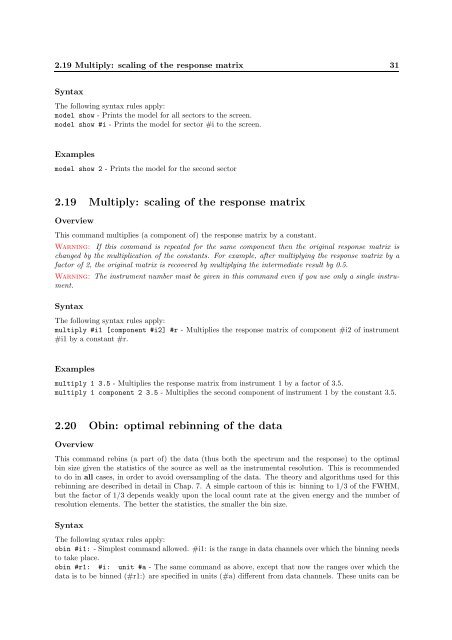SPEX Reference manual (PDF) - SRON
SPEX Reference manual (PDF) - SRON
SPEX Reference manual (PDF) - SRON
Create successful ePaper yourself
Turn your PDF publications into a flip-book with our unique Google optimized e-Paper software.
2.19 Multiply: scaling of the response matrix 31<br />
Syntax<br />
The following syntax rules apply:<br />
model show - Prints the model for all sectors to the screen.<br />
model show #i - Prints the model for sector #i to the screen.<br />
Examples<br />
model show 2 - Prints the model for the second sector<br />
2.19 Multiply: scaling of the response matrix<br />
Overview<br />
This command multiplies (a component of) the response matrix by a constant.<br />
Warning: If this command is repeated for the same component then the original response matrix is<br />
changed by the multiplication of the constants. For example, after multiplying the response matrix by a<br />
factor of 2, the original matrix is recovered by multiplying the intermediate result by 0.5.<br />
Warning: The instrument number must be given in this command even if you use only a single instrument.<br />
Syntax<br />
The following syntax rules apply:<br />
multiply #i1 [component #i2] #r - Multiplies the response matrix of component #i2 of instrument<br />
#i1 by a constant #r.<br />
Examples<br />
multiply 1 3.5 - Multiplies the response matrix from instrument 1 by a factor of 3.5.<br />
multiply 1 component 2 3.5 - Multiplies the second component of instrument 1 by the constant 3.5.<br />
2.20 Obin: optimal rebinning of the data<br />
Overview<br />
This command rebins (a part of) the data (thus both the spectrum and the response) to the optimal<br />
bin size given the statistics of the source as well as the instrumental resolution. This is recommended<br />
to do in all cases, in order to avoid oversampling of the data. The theory and algorithms used for this<br />
rebinning are described in detail in Chap. 7. A simple cartoon of this is: binning to 1/3 of the FWHM,<br />
but the factor of 1/3 depends weakly upon the local count rate at the given energy and the number of<br />
resolution elements. The better the statistics, the smaller the bin size.<br />
Syntax<br />
The following syntax rules apply:<br />
obin #i1: - Simplest command allowed. #i1: is the range in data channels overwhich the binning needs<br />
to take place.<br />
obin #r1: #i: unit #a - The same command as above, except that now the ranges over which the<br />
data is to be binned (#r1:) are specified in units (#a) different from data channels. These units can be

















